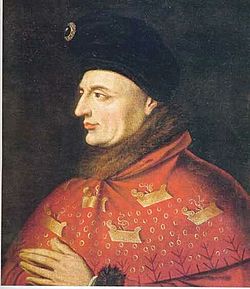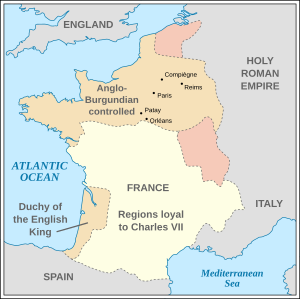Armagnac–Burgundian Civil War facts for kids
Quick facts for kids Armagnac–Burgundian Civil War |
||||||||
|---|---|---|---|---|---|---|---|---|
| Part of the Hundred Years' War | ||||||||
|
||||||||
| Belligerents | ||||||||
|
Armagnac party |
Burgundian party |
England |
||||||
| Commanders and leaders | ||||||||
The Armagnac–Burgundian Civil War was a big fight in France between two powerful families. These families were related to the French king. The war lasted from 1407 to 1435.
It happened during a quiet time in the Hundred Years' War against England. It also happened during a time when there were two popes, which was called the Western Schism.
Contents
Why Did the War Start?
The main leaders of both sides were "princes of the blood". This meant they were close relatives of the French king. They had a lot of power in the kingdom of France. Their arguments over who should control the government led to the war.
- The Orléans family (later called the Armagnacs) was led by Louis I, Duke of Orléans. He was the younger son of King Charles V of France.
- The Burgundy family (the Burgundians) was led by Philip the Bold, the Duke of Burgundy. He was King Charles V's youngest brother.
Both families had their own lands, called appanages. These lands were given to them by the king. But neither Louis nor Philip were next in line to become king.
Different Ways of Life
The war also started because of different ideas about how France should be run. These ideas were about money, society, and religion.
- France was mostly about farming and had a strong feudal system. This system meant that lords owned land and peasants worked for them.
- England had a lot of sheep farming. It also had many skilled workers and important cities.
The Burgundians liked the English way of life. This was because the County of Flanders, which belonged to the Duke of Burgundy, made cloth. This cloth was sold to England, which provided a lot of wool. The Armagnacs preferred the traditional French way.
Who Influenced the King?
King Charles VI of France became mentally ill. So, his wife, Isabeau of Bavaria, led a group of powerful nobles who helped rule the kingdom.
- At first, Philip the Bold, the Duke of Burgundy, had a lot of influence. He had been the king's regent (someone who rules for a child king) when Charles VI was young.
- Later, Louis I, Duke of Orléans, the king's brother, gained more influence. Some people even thought he was the queen's lover.
- When Philip the Bold died, his son, John the Fearless, lost some power at court.
The king's other uncle, John, Duke of Berry, tried to keep the peace between the Orléans and Burgundy families. But their rivalry grew stronger and led to a civil war.
Growing Rivalry and Disagreements
The Duke of Orléans bought lands and castles in areas that the Burgundians thought were theirs. He also got a lot of money from the king. John the Fearless, however, received much less money from the king.
Louis of Orléans wanted to get involved in wars in Italy. He also seemed to want to break the peace with England. This worried John the Fearless. The cloth makers in Flanders, who were under Burgundy's control, needed English wool. A war with England would ruin their business.
At first, the rivalry was polite. Both leaders chose symbols for their supporters. John the Fearless chose the nettle, and Louis of Orléans chose a gnarled stick. John also used the symbol of a plane (a woodworking tool) and gave out badges to his followers.
War Breaks Out
Louis of Orléans was very close to the queen and had the king's favor when the king was well. He managed to push the Burgundians out of power.
John the Fearless was very angry about losing his influence. People were also upset about high taxes, especially since the money seemed to be spent on royal parties. John used this anger to gain support. He promised to cut taxes and reform the government. He won over merchants, common people, and the university in Paris.
In 1405, John threatened Paris with his army, but it wasn't enough to get his power back. So, he decided to get rid of Louis.
The Murder of Louis of Orléans
On November 23, 1407, Louis of Orléans was murdered in Paris. He was leaving the queen's home when fifteen masked attackers, led by a servant of the Duke of Burgundy, stabbed him. Louis's guards could not protect him.
John the Fearless had the support of the people of Paris and the university. He had promised them reforms. He even openly admitted to the murder. A theologian from the Sorbonne university, Jean Petit, even praised the killing, saying it was right to kill a tyrant. This murder started a civil war that would last almost 30 years.
The Civil War Begins
Charles of Orléans, Louis's son, wanted to get revenge for his father's death. He supported anyone who was against the Dukes of Burgundy. In 1409, a peace treaty was signed, but it didn't last.
On April 15, 1410, Charles of Orléans married Bonne d'Armagnac. At the wedding, Charles, his new father-in-law, Bernard VII, Count of Armagnac, and other powerful nobles formed a group against John the Fearless. Bernard VII became the new leader of Charles's side, and they became known as the Armagnac party. Other members included the Dukes of Berry, Bourbon, and Brittany.
Bernard VII gathered fierce fighters from the south of France. They were called the Écorcheurs. They attacked areas around Paris. A new treaty was signed in November 1410, but fighting started again in spring 1411.
In October 1411, John the Fearless entered Paris with a large army. He attacked the Bretons, who were allied with the Armagnacs. John later defeated the Écorcheurs. He then chased the Orléans princes and their allies to Bourges. Another peace treaty was signed in July 1412.
England's Role in the Conflict
The English took advantage of the war in France. They sometimes supported one side or the other, or they simply stayed neutral.
- In 1412, the Armagnacs made a deal with Henry IV of England. They gave him control over some French lands to stop England from joining with Burgundy.
- John the Fearless also managed his relationship with England carefully. He knew that if England stopped selling wool to Flanders, it would hurt his economy.
In 1413, John the Fearless supported a revolt in Paris called the Cabochien Revolt. This led to violence in the city. The people of Paris became scared and asked the Armagnacs for help. The Armagnac troops took back the city in 1414.
When Henry V of England restarted the war in 1415, the Duke of Burgundy stayed neutral. This allowed Henry V to defeat the French army, which was mostly made up of Armagnac soldiers, at the battle of Agincourt.
On May 29, 1418, Paris was taken by troops loyal to the Duke of Burgundy. This happened because someone betrayed the city. On June 12, Bernard VII and other Armagnacs were killed by an angry crowd. John the Fearless was now in control of Paris.
He started talking with the English and seemed willing to accept the English king's claim to the French throne. This made it very important for the French heir, the Dauphin Charles, to make peace with the Burgundians. John the Fearless controlled much of the kingdom, but he was running out of money. So, he agreed to meet the Dauphin to make a good peace deal.
The Murder of John the Fearless
Because John the Fearless had started the trend of assassinations, he himself was murdered on September 10, 1419. This happened on a bridge at Montereau-Fault-Yonne, where he was meeting with the Dauphin Charles.
Both sides had agreed to meet on the bridge. Charles's men accused the Burgundians of not keeping their promises to break ties with the English. Charles's men were also worried that John planned to kidnap or attack the Dauphin. During a fight, the Duke was killed. This murder made it impossible to have peace and helped the English continue their success in the war with Burgundy's help.
What Happened Next?
Philip the Good, John's son and the new Duke of Burgundy, then made an alliance with the English. This led to the Treaty of Troyes.
- This treaty said that the Dauphin Charles would not become king.
- Instead, Henry V of England would become the next king of France by marrying Charles VI's daughter, Catherine of Valois.
- The treaty named Henry "regent and heir of France." But the English only truly controlled northern France.
The Armagnacs strongly disagreed with this treaty. They believed that "the king belongs to the crown and not vice versa." This meant the crown should pass to the rightful heir, not be given away.
Henry V died a few months before his father-in-law, King Charles VI, in 1422. In 1429, Joan of Arc helped Charles VII become king. He was crowned at Reims Cathedral, the traditional place for French kings to be crowned, on July 17, 1429. The ten-year-old Henry VI of England was crowned King of France in Paris in 1431.
How the War Ended
King Charles VII slowly began to take back French lands. He wanted to separate the English from their Burgundian allies.
In 1435, Charles VII signed the Treaty of Arras with Philip the Good. This treaty officially ended the civil war. Philip the Good was excused from having to show loyalty to Charles VII because of his father's murder.
This agreement allowed Charles VII to take back almost all the lands the English held in France. By 1453, the English only had Calais left. Philip the Good later helped free Charles, Duke of Orléans, which finally ended the long feud between the two families.
See also
- Journal d'un bourgeois de Paris




